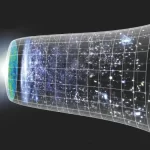Key Takeaways:
- Revolutionary Model: Scientists have developed a groundbreaking model of the universe using Einstein’s complete theory of relativity.
- Complex Code Creation: Research teams from European and US institutions have created sophisticated computer codes to model the universe accurately, considering both clumping and lack of matter.
- Unprecedented Precision: This marks the first time physicists have modeled the universe without simplifications, promising unparalleled accuracy.
- Cosmic Insights: The model explores the intricate relationship between space-time curvature and cosmic matter distribution, offering fresh insights into gravity’s behavior.
- Future of Cosmology: The model sets the stage for handling data from advanced galaxy surveys, pushing the boundaries of precision and accuracy in cosmology.

In a groundbreaking achievement, scientists have harnessed the full power of Albert Einstein’s theory of relativity to construct an unprecedented “map of the universe.” Researchers from esteemed institutions across Europe and the United States collaborated on this endeavor, culminating in the development of two advanced computer codes poised to revolutionize our understanding of the cosmos. These codes promise to deliver the most precise and accurate models of the universe to date, shedding new light on the enigmatic force of gravity and its cosmic ramifications.
What makes this achievement truly remarkable is its departure from convention. Previous attempts to model the universe invariably required simplifications due to the sheer complexity of Einstein’s theory of relativity. However, these newly minted codes represent a significant departure from tradition, as they are the first to incorporate the entire theory, accounting for the intricate interplay between matter’s clumping in some regions and its absence in others.
Marco Bruni, a researcher at the Institute of Cosmology and Gravitation, expressed his enthusiasm, stating, “This is a really exciting development that will help cosmologists create the most accurate possible model of the universe.” As the next decade unfolds, an influx of data from cutting-edge galaxy surveys, facilitated by powerful telescopes and satellites, will inundate researchers. To match the precision of these measurements, cosmologists require theoretical predictions of equal precision and accuracy. These new computer codes are specifically designed to meet this lofty goal and are poised to set a new standard for research that involves simplifying assumptions.
At the core of this model lies the ability to intricately map the relationships between the curvature of space and time and the distribution of matter within the universe. Nevertheless, the researchers acknowledge that further work is needed to comprehensively comprehend the disparities between simplified simulations and the full-fledged model. As Bruni aptly notes, “In the end, as always in physics, it will be the interplay between theory and observations that will further our understanding of the universe.” This groundbreaking achievement represents a pivotal moment in the field of cosmology, ushering in a new era of exploration and discovery in our quest to fathom the mysteries of the universe.


